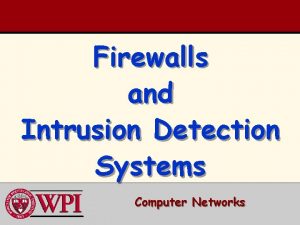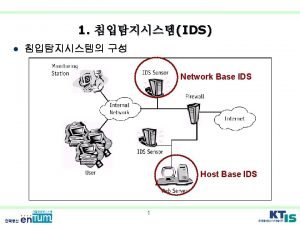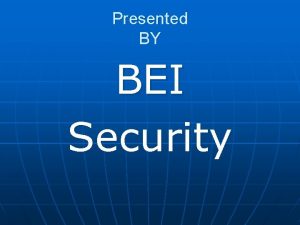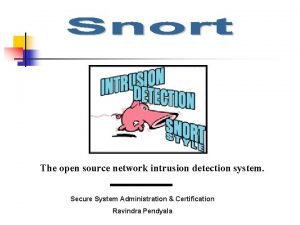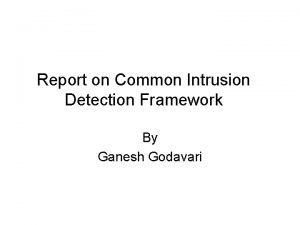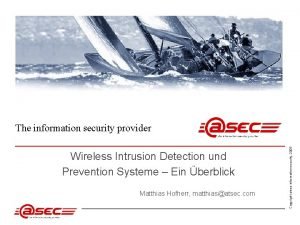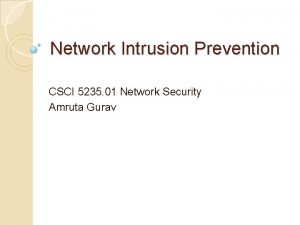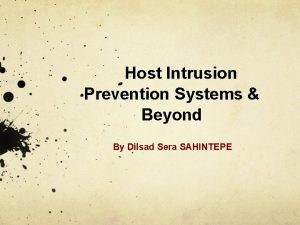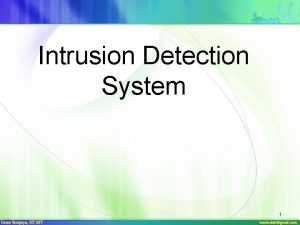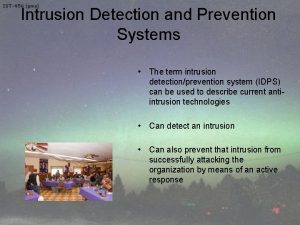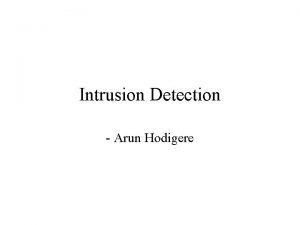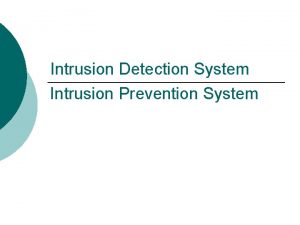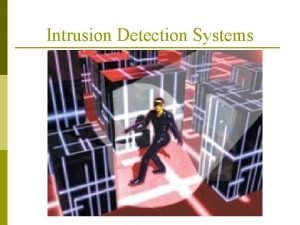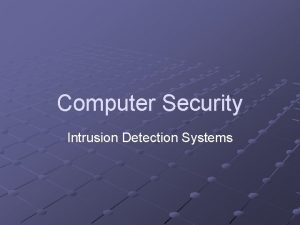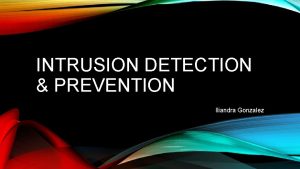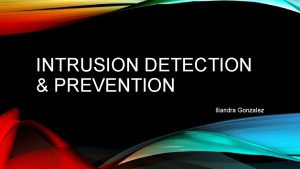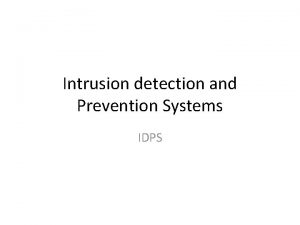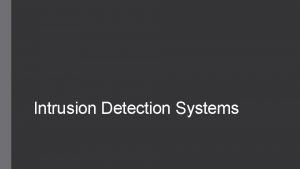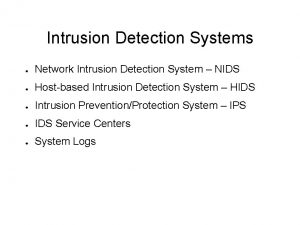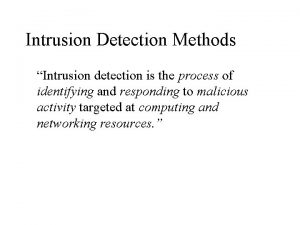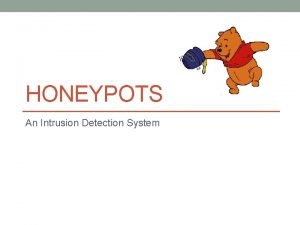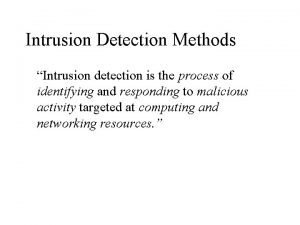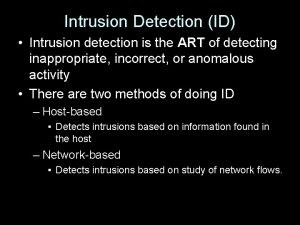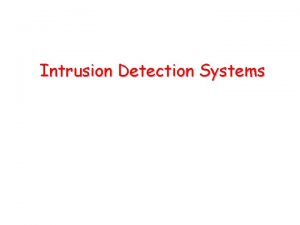Intrusion Detection and Prevention Systems The term intrusion






































- Slides: 38

Intrusion Detection and Prevention Systems • The term intrusion detection/prevention system (IDPS) can be used to describe current antiintrusion technologies • Can detect an intrusion • Can also prevent that intrusion from successfully attacking the organization by means of an active response

Intrusion Detection and Prevention Systems (cont’d. ) • IDPSs work like burglar alarms – Administrators can choose the alarm level – Can be configured to notify administrators via e-mail and numerical or text paging • Like firewall systems, IDPSs require complex configurations to provide the level of detection and response desired

Intrusion Detection and Prevention Systems (cont’d. ) • The newer IDPS technologies – Different from older IDS technologies • IDPS technologies can respond to a detected threat by attempting to prevent it from succeeding – Types of response techniques: • The IDPS stops the attack itself • The IDPS changes the security environment • The IDPS changes the attack’s content

Intrusion Detection and Prevention Systems (cont’d. ) • IDPSs are either network based to protect network information assets – Or host based to protect server or host information assets • IDPS detection methods – Signature based – Statistical anomaly based

Intrusion Detection and Prevention Systems (cont’d. ) Figure 10 -9 Intrusion detection and prevention systems Source: Course Technology/Cengage Learning

Host-Based IDPS • Configures and classifies various categories of systems and data files • IDPSs provide only a few general levels of alert notification • Unless the IDPS is very precisely configured, benign actions can generate a large volume of false alarms • Host-based IDPSs can monitor multiple computers simultaneously

Network-Based IDPS • Monitor network traffic – When a predefined condition occurs, notifies the appropriate administrator • Looks for patterns of network traffic • Match known and unknown attack strategies against their knowledge base to determine whether an attack has occurred • Yield many more false-positive readings than host-based IDPSs

Signature-Based IDPS • Examines data traffic for something that matches the preconfigured, predetermined attack pattern signatures – Also called knowledge-based IDPS – The signatures must be continually updated as new attack strategies emerge – A weakness of this method: • If attacks are slow and methodical, they may slip undetected through the IDPS, as their actions may not match a signature that includes factors based on duration of the events

Statistical Anomaly-Based IDPS • Also called behavior-based IDPS • First collects data from normal traffic and establishes a baseline – Then periodically samples network activity, based on statistical methods, and compares the samples to the baseline – When activity falls outside the baseline parameters (clipping level) • The IDPS notifies the administrator

Statistical Anomaly-Based IDPS (cont’d. ) • Advantage: Able to detect new types of attacks, because it looks for abnormal activity of any type

Managing Intrusion Detection and Prevention Systems • If there is no response to an alert, then an alarm does no good • IDPSs must be configured to differentiate between routine circumstances and low, moderate, or severe threats • A properly configured IDPS can translate a security alert into different types of notifications – A poorly configured IDPS may yield only noise

Wireless Networking Protection • Most organizations that make use of wireless networks use an implementation based on the IEEE 802. 11 protocol • The size of a wireless network’s footprint – Depends on the amount of power the transmitter/receiver wireless access points (WAP) emit – Sufficient power must exist to ensure quality connections within the intended area • But not allow those outside the footprint to connect

Wireless Networking Protection (cont’d. ) • War driving – Moving through a geographic area or building, actively scanning for open or unsecured WAPs • Common encryption protocols used to secure wireless networks – Wired Equivalent Privacy (WEP) – Wi-Fi Protected Access (WPA)

Managing Wireless Connections • One of the first management requirements is to regulate the size of the wireless network footprint – By adjusting the placement and strength of the WAPs • Select WPA or WPA 2 over WEP • Protect preshared keys • Use a VPN

Scanning and Analysis Tools • Used to find vulnerabilities in systems – Holes in security components, and other unsecured aspects of the network • Conscientious administrators frequently browse for new vulnerabilities, recent conquests, and favorite assault techniques • Security administrators may use attacker’s tools to examine their own defenses and search out areas of vulnerability

Scanning and Analysis Tools (cont’d. ) • Scanning tools – Collect the information that an attacker needs to succeed • Footprinting – The organized research of the Internet addresses owned by a target organization • Fingerprinting – The systematic examination of all of the organization’s network addresses • Yields useful information about attack targets

Port Scanners • A port is a network channel or connection point in a data communications system • Port scanning utilities (port scanners) – Identify computers that are active on a network, as well as their active ports and services, the functions and roles fulfilled by the machines, and other useful information

Port Scanners (cont’d. ) • Well-known ports – Those from 0 through 1023 – Registered ports are those from 1024 through 49151 – Dynamic and private ports are those from 49152 through 65535 • Open ports must be secured – Can be used to send commands to a computer, gain access to a server, and exert control over a networking device

Port Scanners (cont’d. ) Table 10 -5 Commonly used port numbers Source: Course Technology/Cengage Learning

Vulnerability Scanners • Capable of scanning networks for very detailed information • Variants of port scanners • Identify exposed user names and groups, show open network shares, and expose configuration problems and other server vulnerabilities

Packet Sniffers • A network tool that collects and analyzes packets on a network – It can be used to eavesdrop on network traffic • Connects directly to a local network from an internal location • To use a packet sniffer legally, you must: – Be on a network that the organization owns – Be directly authorized by the network’s owners – Have the knowledge and consent of the users – Have a justifiable business reason for doing so

Trap and Trace • Growing in popularity • Trap function – Describes software designed to entice individuals who are illegally perusing the internal areas of a network • Trace – A process by which the organization attempts to determine the identity of someone discovered in unauthorized areas of the network or systems

Managing Scanning and Analysis Tools • The security manager must be able to see the organization’s systems and networks from the viewpoint of potential attackers – The security manager should develop a program to periodically scan his or her own systems and networks for vulnerabilities with the same tools that a typical hacker might use • Using in-house resources, contractors, or an outsourced service provider

Managing Scanning and Analysis Tools (cont’d. ) • Drawbacks: – Tools do not have human-level capabilities – Most tools function by pattern recognition, so they only handle known issues – Most tools are computer-based, so they are prone to errors, flaws, and vulnerabilities of their own – Tools are designed, configured, and operated by humans and are subject to human errors

Managing Scanning and Analysis Tools (cont’d. ) • Drawbacks: (cont’d. ) – Some governments, agencies, institutions, and universities have established policies or laws that protect the individual user’s right to access content – Tool usage and configuration must comply with an explicitly articulated policy, and the policy must provide for valid exceptions

Using Cryptographic Controls • Modem cryptosystems can generate unbreakable ciphertext – Possible only when the proper key management infrastructure has been constructed and when the cryptosystems are operated and managed correctly • Cryptographic controls can be used to support several aspects of the business: – Confidentiality and integrity of e-mail and its attachments

Using Cryptographic Controls (cont’d. ) • Cryptographic controls can be used to support several aspects of the business: (cont’d. ) – Authentication, confidentiality, integrity, and nonrepudiation of ecommerce transactions – Authentication and confidentiality of remote access through VPN connections – A higher standard of authentication when used to supplement access control systems

Using Cryptographic Controls (cont’d. ) • IP Security (IPSec) – The primary and dominant cryptographic authentication and encryption product of the IETF’s IP Protocol Security Working Group – Combines several different cryptosystems: • Diffie-Hellman key exchange for deriving key material between peers on a public network • Public key cryptography for signing the Diffie-Hellman exchanges to guarantee the identity of the two parties

Using Cryptographic Controls (cont’d. ) • IP Security (cont’d. ) – Combines several different cryptosystems (cont’d. ) • Bulk encryption algorithms, such as DES, for encrypting the data • Digital certificates signed by a certificate authority to act as digital ID cards

Using Cryptographic Controls (cont’d. ) • IPSec has two components: – The IP Security protocol • Specifies the information to be added to an IP packet and indicates how to encrypt packet data • The Internet Key Exchange, which uses asymmetric key exchange and negotiates the security associations

Using Cryptographic Controls (cont’d. ) • IPSec works in two modes of operation: – Transport • Only the IP data is encrypted, not the IP headers themselves • Allows intermediate nodes to read the source and destination addresses – Tunnel • The entire IP packet is encrypted and inserted as the payload in another IP packet – Often used to support a virtual private network

Using Cryptographic Controls (cont’d. ) • Secure Electronic Transactions (SET) – Developed by Master. Card and VISA to provide protection from electronic payment fraud – Encrypts credit card transfers with DES for encryption and RSA for key exchange • Secure Sockets Layer (SSL) – Developed by Netscape in 1994 to provide security for e-commerce transactions – Uses RSA for key transfer • Uses IDEA, DES, or 3 DES for encrypted symmetric key-based data transfer

Using Cryptographic Controls (cont’d. ) • Secure Hypertext Transfer Protocol – Provides secure e-commerce transactions and encrypted Web pages for secure data transfer over the Web, using different algorithms • Secure Shell (SSH) – Provides security for remote access connections over public networks by using tunneling, authentication services between a client and a server

Using Cryptographic Controls (cont’d. ) • Secure Shell (cont’d. ) – Used to secure replacement tools for terminal emulation, remote management, and file transfer applications

Using Cryptographic Controls (cont’d. ) • Cryptosystems provide enhanced and secure authentication – One approach is provided by Kerberos, which uses symmetric key encryption to validate an individual user’s access to various network resources • Keeps a database containing the private keys of clients and servers that are in the authentication domain that it supervises

Using Cryptographic Controls (cont’d. ) • Cryptosystems provide enhanced and secure authentication (cont’d. ) – Kerberos system knows these private keys and can authenticate one network node (client or server) to another – Kerberos also generates temporary session keys—that is, private keys given to the two parties in a conversation

Managing Cryptographic Controls • Don’t lose your keys • Know who you are communicating with • It may be illegal to use a specific encryption technique when communicating to some nations • Every cryptosystem has weaknesses • Give access only to those with a business need • When placing trust into a certificate authority, ask “Who watches the watchers? ”

Managing Cryptographic Controls (cont’d. ) • There is no security in obscurity • Security protocols and the cryptosystems they use are installed and configured by humans – They are only as good as their installers • Make sure that your organization’s use of cryptography is based on well-constructed policy and supported with sound management procedures
 Primary prevention secondary prevention tertiary prevention
Primary prevention secondary prevention tertiary prevention Ids sensors
Ids sensors L
L Fiber optic perimeter intrusion detection systems
Fiber optic perimeter intrusion detection systems Nids open source
Nids open source Common intrusion detection framework
Common intrusion detection framework Bro ids hardware requirements
Bro ids hardware requirements Infrasonic intrusion detection
Infrasonic intrusion detection Datenkorrelation
Datenkorrelation Configure ios intrusion prevention system (ips) using cli
Configure ios intrusion prevention system (ips) using cli Host intrusion prevention system
Host intrusion prevention system Starvation deadlock
Starvation deadlock Deadlock prevention avoidance and detection
Deadlock prevention avoidance and detection Lightening radar
Lightening radar Short term planning and long term planning
Short term planning and long term planning Short term human resources
Short term human resources Difference between long term and short term liabilities
Difference between long term and short term liabilities Difference between long term and short term liabilities
Difference between long term and short term liabilities Example of short term goal
Example of short term goal Short term and long term cash forecasting
Short term and long term cash forecasting In my understanding
In my understanding Long term memory vs short term memory
Long term memory vs short term memory Site:slidetodoc.com
Site:slidetodoc.com Term-to-term rule
Term-to-term rule Maxterm expansion
Maxterm expansion Term to term rule example
Term to term rule example Term to term rule
Term to term rule Hát kết hợp bộ gõ cơ thể
Hát kết hợp bộ gõ cơ thể Ng-html
Ng-html Bổ thể
Bổ thể Tỉ lệ cơ thể trẻ em
Tỉ lệ cơ thể trẻ em Chó sói
Chó sói Tư thế worms-breton
Tư thế worms-breton Alleluia hat len nguoi oi
Alleluia hat len nguoi oi Các môn thể thao bắt đầu bằng tiếng chạy
Các môn thể thao bắt đầu bằng tiếng chạy Thế nào là hệ số cao nhất
Thế nào là hệ số cao nhất Các châu lục và đại dương trên thế giới
Các châu lục và đại dương trên thế giới Công thức tiính động năng
Công thức tiính động năng Trời xanh đây là của chúng ta thể thơ
Trời xanh đây là của chúng ta thể thơ

